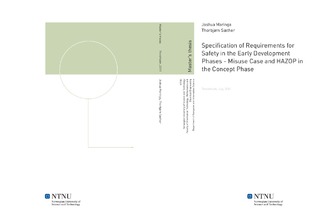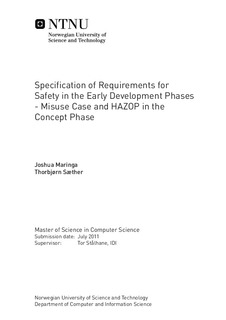| dc.contributor.advisor | Stålhane, Tor | nb_NO |
| dc.contributor.author | Maringa, Joshua | nb_NO |
| dc.contributor.author | Sæther, Thorbjørn | nb_NO |
| dc.date.accessioned | 2014-12-19T13:37:46Z | |
| dc.date.available | 2014-12-19T13:37:46Z | |
| dc.date.created | 2011-10-03 | nb_NO |
| dc.date.issued | 2011 | nb_NO |
| dc.identifier | 445186 | nb_NO |
| dc.identifier | ntnudaim:6056 | nb_NO |
| dc.identifier.uri | http://hdl.handle.net/11250/252614 | |
| dc.description.abstract | In the course TDT4520 - Specialization Project, the preparatory course to this thesis, we looked at several safety analysis methods and how they could be exploited to identify software hazards in the early stages of development. After our evaluation, and with the results from a survey conducted on experts in the field, we proposed a procedure to improve software hazard identification in the concept phase of projects. The procedure consisted of a Misuse Case analysis with a sub-sequential HAZOP analysis. Our case study showed that this procedure will indeed aid in the identification process. However, testing the procedure on others is needed to see if this is correct. That is the main theme for this thesis. We performed an experiment with undergraduate students and an interview with an expert in the field. We use the results from the experiment to validate our assumptions and identify modifications that might be needed. The experiment gave us a good illustration of how the procedure would work in a real hazard analysis project, and the data collected showed us the differences between it and the more commonly used Preliminary Hazard Analysis. Our hypothesis was that the Misuse Case and HAZOP approach would improve the hazard identification with focus on software. The experiment resulted in no clear difference in non-software parts of the system, but a clear improvement on the software parts. Afterwards we conducted an interview with an expert in the field, in which we clarified many of our questions and assumptions, and aided us in modifying the procedure to the better.Although the procedure still needs to be tested thoroughly with real projects in the industry to make a final decision on whether it has merit or not, our conclusion is that the procedure deserves further attention. Software hazard identification in the concept phase is difficult but based on our findings, the Misuse Case and HAZOP combination can improve this problem. | nb_NO |
| dc.language | eng | nb_NO |
| dc.publisher | Institutt for datateknikk og informasjonsvitenskap | nb_NO |
| dc.subject | ntnudaim:6056 | no_NO |
| dc.subject | MSINFOSYST Master in Information Systems | no_NO |
| dc.subject | Information Systems Engineering | no_NO |
| dc.subject | MTDT datateknikk | no_NO |
| dc.subject | Program- og informasjonssystemer | no_NO |
| dc.title | Specification of Requirements for Safety in the Early Development Phases - Misuse Case and HAZOP in the Concept Phase | nb_NO |
| dc.type | Master thesis | nb_NO |
| dc.source.pagenumber | 148 | nb_NO |
| dc.contributor.department | Norges teknisk-naturvitenskapelige universitet, Fakultet for informasjonsteknologi, matematikk og elektroteknikk, Institutt for datateknikk og informasjonsvitenskap | nb_NO |

